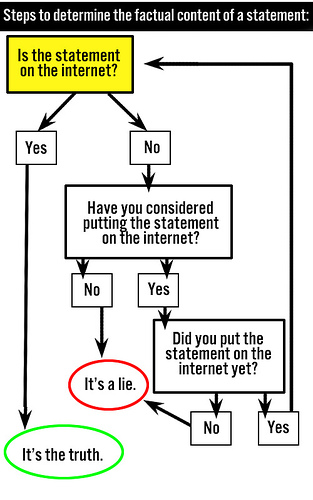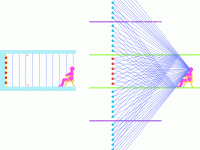As we approaches teaching.....
There are basicly two kinds of teachers
One will teach his own "understanding"
The other teach "to think"
Both are worth their own weight in gold
Just very very different
maybe also bare in mind that the most brilliant minds in history have all been people going against common practice and established knowledge
There are basicly two kinds of teachers
One will teach his own "understanding"
The other teach "to think"
Both are worth their own weight in gold
Just very very different
maybe also bare in mind that the most brilliant minds in history have all been people going against common practice and established knowledge
Hello
They can if the propagating waves are chenalized.
See attached file:
Top and bottom horizontal walls creates an infinity of virtual sources of the loudspeakers forming an infinite line array. If wavelength is large compared to the distance between the centers of the neighbouring loudspeakers then a cylindrical wave is formed.
Best regards from Paris, France
Jean-Michel Le Cléac'h
They can if the propagating waves are chenalized.
See attached file:
Top and bottom horizontal walls creates an infinity of virtual sources of the loudspeakers forming an infinite line array. If wavelength is large compared to the distance between the centers of the neighbouring loudspeakers then a cylindrical wave is formed.
Best regards from Paris, France
Jean-Michel Le Cléac'h
Can Line Arrays Form Cylindrical Waves?
Attachments
Hello Soongsc,
No phase cancellation at very low frequency (that's why I wrote : when the wavelength is large...)
Best regards from Paris, France
Jean-Michel Le Cléac'h
No phase cancellation at very low frequency (that's why I wrote : when the wavelength is large...)
Best regards from Paris, France
Jean-Michel Le Cléac'h
aren't the phase cancellations missing from this?
he claims to have extensive experience in electrical engineering, acoustical engineering and quantum physics

"I've provided to the Meyer Sound link establishes physical proof that sound waves don't reflect off of one another."
Neither do EM waves, who said anything different?
Thought experiment - If a speaker launches a wave and nothing is reflected how does it know how long the pipe is? In other words how does the "system" know what frequency to resonate at?
You can not determine the length of a piece of perfectly terminated transmission line with an electrical measurement. Measuring DC R does not count. The acoustic/EM analogies are useful but break down a little with adiabatic heating issues.
Neither do EM waves, who said anything different?
Thought experiment - If a speaker launches a wave and nothing is reflected how does it know how long the pipe is? In other words how does the "system" know what frequency to resonate at?
You can not determine the length of a piece of perfectly terminated transmission line with an electrical measurement. Measuring DC R does not count. The acoustic/EM analogies are useful but break down a little with adiabatic heating issues.
Beautiful! Best argument I've seen all day, Scott.Thought experiment - If a speaker launches a wave and nothing is reflected how does it know how long the pipe is? In other words how does the "system" know what frequency to resonate at?
Oh, wait - Villastrangiato already told us the resonances are at multiples of the Driver's Fs, irrespective of the length of the pipe.

Nice try though. sigh...
Sound waves will reflect (bounce) off the sidewalls of the pipe also - that is the main cause of the resonance, not the reflection (or lack there of) off the open end. The longer the pipe, the deeper the resonance.
Here's how villastrangiato has chosen to deal with the situation
General Asylum - Moderator/Buddy Circle Censorship?? - villastrangiato - March 05, 2010 at 09:25:48
General Asylum - Moderator/Buddy Circle Censorship?? - villastrangiato - March 05, 2010 at 09:25:48
I was thinking, if the wavelength is long enough to consider the length of the array small, the the wave front would be considered spherical. If the length of the line array compared to the wavelength might suggest a cylinder, then the wavelength is small enough that phase cancellation may occur. So there has to be a very specific range of wavelength to array length ratio that we might be able to say a cylinder wave front will occur even if possible. I have not calculated the range though.Hello Soongsc,
No phase cancellation at very low frequency (that's why I wrote : when the wavelength is large...)
Best regards from Paris, France
Jean-Michel Le Cléac'h
That's what I used to do when I was in kindergarten😱😀Here's how villastrangiato has chosen to deal with the situation
General Asylum - Moderator/Buddy Circle Censorship?? - villastrangiato - March 05, 2010 at 09:25:48
I must be getting old enough to start having these flashbacks🙄
At the frequencies we're talking about with TLs, where a wavelength is 4x the length of the pipe at resonance, the wave is too large to do much bouncing off the pipe walls.Sound waves will reflect (bounce) off the sidewalls of the pipe also - that is the main cause of the resonance, not the reflection (or lack there of) off the open end. The longer the pipe, the deeper the resonance.
I hope he's happy over there and they like his attitude and aren't paticularly concerned about technical accuracy or don't need tangible proof that his claims are correct.
Paul
Paul
Here's how villastrangiato has chosen to deal with the situation
General Asylum - Moderator/Buddy Circle Censorship?? - villastrangiato - March 05, 2010 at 09:25:48
Sound waves will reflect (bounce) off the sidewalls of the pipe also - that is the main cause of the resonance, not the reflection (or lack there of) off the open end. The longer the pipe, the deeper the resonance.
I do not believe that is correct. The length of the bass sound wave is so long that the cross-section dimensions are not the primary direction of travel. It is really a 1D wave equation problem directed along the length of the TL and all reflections are due to the line's end boundary conditions (driver acting as a closed end and opposite end left open to the room).
At the frequencies we're talking about with TLs, where a wavelength is 4x the length of the pipe at resonance, the wave is too large to do much bouncing off the pipe walls.
Are you sure about that? As the wave propagates, it reflects off of the sidewall and makes its way down the pipe. Reaching the open end it reflects back up the pipe.
Approaching the open end at an oblique angle (as reflected from the sidewall) the reflection will be stronger and more coherent than if it comes dead on. For example: a bullet can reflect off of glass at an oblique angle.
Are you sure about that?
I belive he has it correct. There are no side wall reflections at low frequencies.
Sound waves will reflect (bounce) off the sidewalls of the pipe also - that is the main cause of the resonance, not the reflection (or lack there of) off the open end. The longer the pipe, the deeper the resonance.
This is a little mixed up but I know better than to argue with you. 😀
I belive he has it correct. There are no side wall reflections at low frequencies.
There must be, otherwise there would be no resonance - not enough energy would remain in the pipe to excite the column of air.
- Status
- Not open for further replies.
- Home
- Loudspeakers
- Multi-Way
- Real Expert or Just Self Proclaimed

